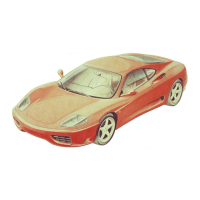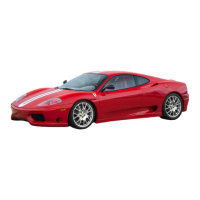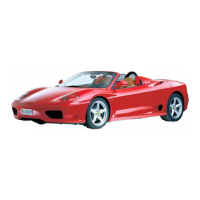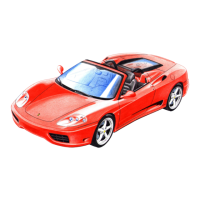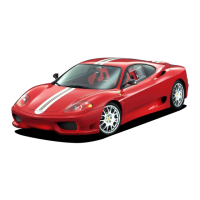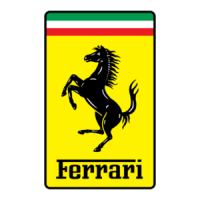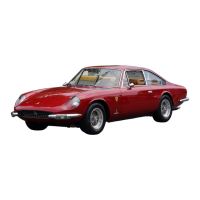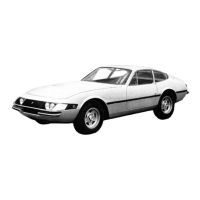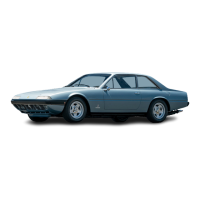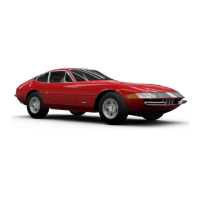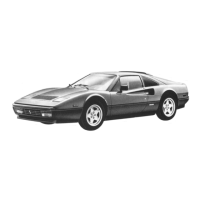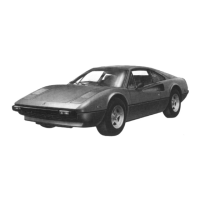Do you have a question about the Ferrari 360 Modene 2002 and is the answer not in the manual?
Explains how the car marks an evolution in design for Ferrari 8-cylinder cars.
Explains how the manual is divided into sections and chapters for user-friendliness.
Lists plates for chassis, engine, and assembly numbers.
Lists plates for paint reference, lubricants, fuel, and tire pressure.
Indicates the driving speed and has a miles counter.
Indicates the engine revolution speed and has a red zone to avoid.
Signals a fault with the ABS system. Normal braking system functions.
Signals low fluid or worn pads. EBD failure indicated by ABS and ASR lights.
Indicates the parking brake is engaged.
Indicates AIR BAG or seatbelt pre-tensioners not working properly.
Indicates driver's seatbelt is not fastened when ignition is on.
Indicates charging system defects or abnormal battery charge.
Indicates a fault with the F1 transmission, accompanied by an audible signal.
Indicates failures in emission control or ignition/injection systems.
Signals when direction lights or hazard lights are activated.
Indicates when dimmers or low beams are switched on.
Indicates when high beams are switched on or used for flashing.
Indicates when the parking lights button is pressed.
Activated rear window/mirror defogging units, turn off automatically after 30 mins.
Controls car setting for "SPORT" mode.
Indicates when "low grip" mode is selected.
Indicates risk of rear wheel lock-up due to EBD inefficiency. Stop the car.
Indicates the electronic system performed self-checks successfully, allowing engine start.
Indicates the fuel tank flap is open or not closed properly.
Displays the outside temperature when selected.
Indicates ASR intervention while driving.
Indicates low fuel or fuel level indicator fault.
Signals inertia switch activation after an accident.
Signals a fault in the suspension system.
Signals a fault or exclusion of the ASR system.
Displays adjustable instrument panel lighting brightness.
Signals excessively high exhaust system temperature.
Signals simultaneous activation of all direction indicators.
Signals insufficient washer fluid.
Indicates hoods are open or not closed properly.
Indicates luggage compartment hood is open or not closed properly.
Indicates engine compartment hood is open or not closed properly.
Indicates doors are open or not closed properly.
Indicates driver's door is open or not closed properly.
Indicates passenger's door is open or not closed properly.
Indicates the battery charger is still active.
Activated by pressing switch (A), all direction indicators flash. Functions regardless of ignition key position.
Activated by pressing switch (D), turn on position lights. Function regardless of ignition key position.
Activated by button (F), lights (G) and (H) indicate use. Turns off automatically after 30 mins.
Disables ASR system. "ASR" icon appears on display.
Controls car setting for "SPORT" mode.
Explains automatic window lowering/raising for door opening/closing.
How to disable alarm and central locking.
Explains how to release door lock if handle is used.
Explains how to release door lock if handle is used.
Red light (H) indicates open door.
Intermittent warning signal activated when ignition key is turned to "II" with driver's door open.
Window opens or closes. Manual or automatic operation.
Adjusts seat lengthwise and backrest angle.
Adjusts lumbar support by rotating knob (C).
Adjusts side support width by rotating knob (D).
Tilts seat back forward using lever (E).
Adjusts headrest height (F). Proper positioning is crucial for safety.
Manually positioned. Lever (A) for anti-glare effect.
Electrically positioned. Selector (B) for left/right. Button (C) for vertical/horizontal adjustment.
Intervenes in impact. Includes seatbelts, airbags, body deformation, and inertia switch.
Designed to prevent collisions. Includes braking, A/C, lights, horn/flashers.
Correctly position seatback/headrest, then attach belt. Check lock.
Use button (D) to adjust height. Check lock. Position correctly for safety.
Push release button (E), place tongue (A) in resting position.
Activates during frontal collision, retracts belt for better fit.
Replace belt after collision, check anchors, keep belt clean.
Children are at higher risk. Use appropriate restraint systems.
Instructions for installing child seats, especially in USA/Canada.
Two cushions, driver's side (A) and passenger's side (B).
Controlled by sensor/ECU. Inflates with combustion. Deflates instantly. Avoid objects that could cause injury.
Push cover (A) back to access. Pull up to clean.
Mirror (B) on the back of the passenger side sun visor.
Pull lever (E) if button (A) fails.
Automatic and Manual modes for temperature and air distribution.
Lists controls for A/C, air distribution, temperature, fan speed, and recirculation.
Controls A/C operation (On/Off).
Automatic and Manual modes for air distribution.
Activates defogging/defrosting for windshield and side windows.
Sets desired temperature. "LO" and "HI" for min/max settings.
Automatic and Manual modes for fan speed.
Controls air source (outside/recirculated).
Initial period for engine and transmission settling.
Preliminary checks before long trips.
General driving advice.
Procedures for starting and driving with manual transmission.
Procedures for starting and driving with F1 transmission.
How to park the vehicle safely.
Essential techniques for safe driving.
Importance of proper vehicle care for environmental protection.
Periodic checks for tires, fluids, wipers, lights.
Use unleaded fuel only. Avoid fuel with lead.
Procedures for starting the engine, including safety checks and troubleshooting.
Procedures for activating the F1 transmission system, including display and warning lights.
Procedures for operating the F1 transmission with the engine off.
System automatically downshifts if engine speed drops below minimum RPM.
Automatic double-clutch downshifting in "SPORT" mode.
How to request neutral at any speed.
System engages higher gear automatically if engine speed nears runaway rate.
System automatically downshifts if engine speed drops below minimum RPM.
Used for slippery surfaces (snow, ice). Activated by switch (D). Utilizes 2nd gear instead of 1st.
Lists tools for emergency repairs in the luggage compartment.
Must be stored in its case (C) in the luggage compartment.
Lists tire type and pressure.
Improper use of spare wheel or exceeding speed limits can cause loss of control.
Check fuse before replacing headlight bulb. Turn wheels and dismount flap (A) for access.
Turn battery switch to OFF. Rotate support (C) to remove bulb (D).
XENON lamps, high voltage. Avoid operation when ignition is in "II". Contact FERRARI ASSISTANCE NETWORK for replacement.
Lever out lamp (P), replace bulb (Q/R).
Lever out holder (S), replace bulb (T).
Lists fuse colors corresponding to amperage.
Lists maxi fuse colors corresponding to amperage.
Consult "BATTERY" chapter for maintenance. Access battery by removing footrest panel (A).
Use 12V external battery. Ensure suitable charger is used by skilled personnel. Use proper cables.
Use designated hook (A) in seat (B). Screw tightly. Place gearshift in Neutral ("N") for F1 transmission. Observe road regulations. Do not hook suspension arms or rims.
Must be done by skilled personnel. Only rear axle may be lifted. Ensure front wheels are straight and steering lock is engaged.
After checking for fuel leaks, remove cover (B), press button (C), turn ignition to "II", wait, then start engine. Re-check for leaks.
Each operation has a number and description in the key. Refers to oil types on page 6.11.
Check oil level when engine is warm. Unscrew cap (A). Top up if necessary.
Check oil level when engine is warm, after driving 10 miles. Remove cap (B). Top up if low.
Disconnects battery ground cable using switch (D) in luggage compartment.
Turn wiper on, lock ignition to "0" when blades are vertical.
Keep tires in good condition. Follow inflation pressure. Avoid sudden acceleration/braking. Drive moderately.
Comparative rating based on wear rate in controlled tests.
Clean rim with heptane, remove protective paper, apply weight evenly.
Preserve paint. Avoid wet/dirty areas. Clean underbody regularly. Wash carefully. Never use hot water/steam.
Correct procedure described on page 4.4.
Lists tire type and pressure.
Detects engine timing by generating electrical signal.
Informs ECU of air volume and temperature.
Detects engine timing by generating electrical signal.
Informs ECU of air volume and temperature.
Two sensors per system, control exhaust emissions.
NTC sensor on water outlet, transmits temp. data to ECU.
Located on motor-driven throttle bodies, transmit throttle opening info.
Secured to crankcase, detect detonation symmetrically.
Manages hydraulic control of timing variator.
Spray fuel directly into intake duct.
Closed circuit type, connected to spark plug via silicon extension.
Pedal works independently from throttle. Uses potentiometers instead of cables.
Mechanically fastened to pedal. Transmits pedal position to ECU for torque calculation.
Installed between air-flow meter and plenum. Contains throttle valve, motor, potentiometers. Allows optimal traction control.
Checked or replaced by FERRARI SERVICE NETWORK as coil must be removed.
Dry, single-plate type with hydraulic release control. Features advanced wear.
6 synchronized gears + reverse. Quick engagement. Double/triple cone synchronizers. Manual control via lever, selector, turret, Bowden cables. Contains crown wheel, pinion, self-locking differential.
Lubrication of gears shared with differential. Provided by volumetric gear pump driven by reverse gear.
3 turns for full lock-to-lock steering.
10.8 meters.
Hydraulic steering, electronically controlled, servo-assisted. Improved steering feel with speed.
Unit contains heater/evaporator, provides heated/cooled/dehumidified air.
Mounted in series with right radiator. Shares electric fan. Controlled by pressure switch/double-contact switch.
Braking system component.
Braking system component.
Braking system fluid.
ABS system component.
ABS/ASR system control.
Lighting system component.
Reservoir found in front compartment, shared with clutch system for mechanical transmissions.
Max. free travel should be 8-10 mm. Check for excessive travel.
Front pads have wear indicators. Check thickness and condition. Minimum thickness 3mm.
Warning light signals excessive wear. Unauthorized replacement relieves Ferrari of liability. Avoid sudden braking after replacement.
Prevents wheel lock-up during hard braking.
Electro-hydraulic unit, EBD software, speed sensors, wiring.
Prevents wheel spin during acceleration. Acts on engine management and rear brake pressure.
Integrated with ABS, controlled by Motronic ECU.
Activates with ignition key in "II". Can be disabled by switch. "ASR" icon (amber) appears when active.
"ASR ACTIVE" (green) indicates ASR activation. Signals braking anomalies.
Prioritizes stability in low/medium grip.
Prioritizes traction and performance.
Do not select "SPORT" with ASR enabled.
Signals braking system irregularities. Contact FERRARI for issues.
Check tire wear and alignment intervals per Maintenance Plan. Contact FERRARI SERVICE CENTER.
Body produced from aluminum for weight reduction, higher stability, and corrosion resistance.
Composed of extruded sections, cast knots, and reinforcement sheets.
Exterior panels like bumpers, side panels, roof, joined by various techniques. Moving parts are fastened with screws.
Aluminum parts usually require replacement. Welding for space frame. Other repairs by adhesive, riveting, bolting, welding. Hot straightening up to 200°C. Repairs by expert mechanics only.
Detects and signals component malfunctions.
Connects to “SD-2 DIAGNOSTIC SYSTEM” for diagnosis.
Errors recorded in memory, can be deleted or are permanent.
High-speed data transfer between ECUs for intelligent vehicle control.
Correct procedure described on page 4.4.
Lists tire type and pressure.
Explains how the car marks an evolution in design for Ferrari 8-cylinder cars.
Explains how the manual is divided into sections and chapters for user-friendliness.
Lists plates for chassis, engine, and assembly numbers.
Lists plates for paint reference, lubricants, fuel, and tire pressure.
Indicates the driving speed and has a miles counter.
Indicates the engine revolution speed and has a red zone to avoid.
Signals a fault with the ABS system. Normal braking system functions.
Signals low fluid or worn pads. EBD failure indicated by ABS and ASR lights.
Indicates the parking brake is engaged.
Indicates AIR BAG or seatbelt pre-tensioners not working properly.
Indicates driver's seatbelt is not fastened when ignition is on.
Indicates charging system defects or abnormal battery charge.
Indicates a fault with the F1 transmission, accompanied by an audible signal.
Indicates failures in emission control or ignition/injection systems.
Signals when direction lights or hazard lights are activated.
Indicates when dimmers or low beams are switched on.
Indicates when high beams are switched on or used for flashing.
Indicates when the parking lights button is pressed.
Activated rear window/mirror defogging units, turn off automatically after 30 mins.
Controls car setting for "SPORT" mode.
Indicates when "low grip" mode is selected.
Indicates risk of rear wheel lock-up due to EBD inefficiency. Stop the car.
Indicates the electronic system performed self-checks successfully, allowing engine start.
Indicates the fuel tank flap is open or not closed properly.
Displays the outside temperature when selected.
Indicates ASR intervention while driving.
Indicates low fuel or fuel level indicator fault.
Signals inertia switch activation after an accident.
Signals a fault in the suspension system.
Signals a fault or exclusion of the ASR system.
Displays adjustable instrument panel lighting brightness.
Signals excessively high exhaust system temperature.
Signals simultaneous activation of all direction indicators.
Signals insufficient washer fluid.
Indicates hoods are open or not closed properly.
Indicates luggage compartment hood is open or not closed properly.
Indicates engine compartment hood is open or not closed properly.
Indicates doors are open or not closed properly.
Indicates driver's door is open or not closed properly.
Indicates passenger's door is open or not closed properly.
Indicates the battery charger is still active.
Activated by pressing switch (A), all direction indicators flash. Functions regardless of ignition key position.
Activated by pressing switch (D), turn on position lights. Function regardless of ignition key position.
Activated by button (F), lights (G) and (H) indicate use. Turns off automatically after 30 mins.
Disables ASR system. "ASR" icon appears on display.
Controls car setting for "SPORT" mode.
Explains automatic window lowering/raising for door opening/closing.
How to disable alarm and central locking.
Explains how to release door lock if handle is used.
Explains how to release door lock if handle is used.
Red light (H) indicates open door.
Intermittent warning signal activated when ignition key is turned to "II" with driver's door open.
Window opens or closes. Manual or automatic operation.
Adjusts seat lengthwise and backrest angle.
Adjusts lumbar support by rotating knob (C).
Adjusts side support width by rotating knob (D).
Tilts seat back forward using lever (E).
Adjusts headrest height (F). Proper positioning is crucial for safety.
Manually positioned. Lever (A) for anti-glare effect.
Electrically positioned. Selector (B) for left/right. Button (C) for vertical/horizontal adjustment.
Intervenes in impact. Includes seatbelts, airbags, body deformation, and inertia switch.
Designed to prevent collisions. Includes braking, A/C, lights, horn/flashers.
Correctly position seatback/headrest, then attach belt. Check lock.
Use button (D) to adjust height. Check lock. Position correctly for safety.
Push release button (E), place tongue (A) in resting position.
Activates during frontal collision, retracts belt for better fit.
Replace belt after collision, check anchors, keep belt clean.
Children are at higher risk. Use appropriate restraint systems.
Instructions for installing child seats, especially in USA/Canada.
Two cushions, driver's side (A) and passenger's side (B).
Controlled by sensor/ECU. Inflates with combustion. Deflates instantly. Avoid objects that could cause injury.
Push cover (A) back to access. Pull up to clean.
Mirror (B) on the back of the passenger side sun visor.
Pull lever (E) if button (A) fails.
Automatic and Manual modes for temperature and air distribution.
Lists controls for A/C, air distribution, temperature, fan speed, and recirculation.
Controls A/C operation (On/Off).
Automatic and Manual modes for air distribution.
Activates defogging/defrosting for windshield and side windows.
Sets desired temperature. "LO" and "HI" for min/max settings.
Automatic and Manual modes for fan speed.
Controls air source (outside/recirculated).
Initial period for engine and transmission settling.
Preliminary checks before long trips.
General driving advice.
Procedures for starting and driving with manual transmission.
Procedures for starting and driving with F1 transmission.
How to park the vehicle safely.
Essential techniques for safe driving.
Importance of proper vehicle care for environmental protection.
Periodic checks for tires, fluids, wipers, lights.
Use unleaded fuel only. Avoid fuel with lead.
Procedures for starting the engine, including safety checks and troubleshooting.
Procedures for activating the F1 transmission system, including display and warning lights.
Procedures for operating the F1 transmission with the engine off.
System automatically downshifts if engine speed drops below minimum RPM.
Automatic double-clutch downshifting in "SPORT" mode.
How to request neutral at any speed.
System engages higher gear automatically if engine speed nears runaway rate.
System automatically downshifts if engine speed drops below minimum RPM.
Used for slippery surfaces (snow, ice). Activated by switch (D). Utilizes 2nd gear instead of 1st.
Lists tools for emergency repairs in the luggage compartment.
Must be stored in its case (C) in the luggage compartment.
Lists tire type and pressure.
Improper use of spare wheel or exceeding speed limits can cause loss of control.
Check fuse before replacing headlight bulb. Turn wheels and dismount flap (A) for access.
Turn battery switch to OFF. Rotate support (C) to remove bulb (D).
XENON lamps, high voltage. Avoid operation when ignition is in "II". Contact FERRARI ASSISTANCE NETWORK for replacement.
Lever out lamp (P), replace bulb (Q/R).
Lever out holder (S), replace bulb (T).
Lists fuse colors corresponding to amperage.
Lists maxi fuse colors corresponding to amperage.
Consult "BATTERY" chapter for maintenance. Access battery by removing footrest panel (A).
Use 12V external battery. Ensure suitable charger is used by skilled personnel. Use proper cables.
Use designated hook (A) in seat (B). Screw tightly. Place gearshift in Neutral ("N") for F1 transmission. Observe road regulations. Do not hook suspension arms or rims.
Must be done by skilled personnel. Only rear axle may be lifted. Ensure front wheels are straight and steering lock is engaged.
After checking for fuel leaks, remove cover (B), press button (C), turn ignition to "II", wait, then start engine. Re-check for leaks.
Each operation has a number and description in the key. Refers to oil types on page 6.11.
Check oil level when engine is warm. Unscrew cap (A). Top up if necessary.
Check oil level when engine is warm, after driving 10 miles. Remove cap (B). Top up if low.
Disconnects battery ground cable using switch (D) in luggage compartment.
Turn wiper on, lock ignition to "0" when blades are vertical.
Keep tires in good condition. Follow inflation pressure. Avoid sudden acceleration/braking. Drive moderately.
Comparative rating based on wear rate in controlled tests.
Clean rim with heptane, remove protective paper, apply weight evenly.
Preserve paint. Avoid wet/dirty areas. Clean underbody regularly. Wash carefully. Never use hot water/steam.
Correct procedure described on page 4.4.
Lists tire type and pressure.
Detects engine timing by generating electrical signal.
Informs ECU of air volume and temperature.
Detects engine timing by generating electrical signal.
Informs ECU of air volume and temperature.
Two sensors per system, control exhaust emissions.
NTC sensor on water outlet, transmits temp. data to ECU.
Located on motor-driven throttle bodies, transmit throttle opening info.
Secured to crankcase, detect detonation symmetrically.
Manages hydraulic control of timing variator.
Spray fuel directly into intake duct.
Closed circuit type, connected to spark plug via silicon extension.
Pedal works independently from throttle. Uses potentiometers instead of cables.
Mechanically fastened to pedal. Transmits pedal position to ECU for torque calculation.
Installed between air-flow meter and plenum. Contains throttle valve, motor, potentiometers. Allows optimal traction control.
Checked or replaced by FERRARI SERVICE NETWORK as coil must be removed.
Dry, single-plate type with hydraulic release control. Features advanced wear.
6 synchronized gears + reverse. Quick engagement. Double/triple cone synchronizers. Manual control via lever, selector, turret, Bowden cables. Contains crown wheel, pinion, self-locking differential.
Lubrication of gears shared with differential. Provided by volumetric gear pump driven by reverse gear.
3 turns for full lock-to-lock steering.
10.8 meters.
Hydraulic steering, electronically controlled, servo-assisted. Improved steering feel with speed.
Unit contains heater/evaporator, provides heated/cooled/dehumidified air.
Mounted in series with right radiator. Shares electric fan. Controlled by pressure switch/double-contact switch.
Braking system component.
Braking system component.
Braking system fluid.
ABS system component.
ABS/ASR system control.
Lighting system component.
Reservoir found in front compartment, shared with clutch system for mechanical transmissions.
Max. free travel should be 8-10 mm. Check for excessive travel.
Front pads have wear indicators. Check thickness and condition. Minimum thickness 3mm.
Warning light signals excessive wear. Unauthorized replacement relieves Ferrari of liability. Avoid sudden braking after replacement.
Prevents wheel lock-up during hard braking.
Electro-hydraulic unit, EBD software, speed sensors, wiring.
Prevents wheel spin during acceleration. Acts on engine management and rear brake pressure.
Integrated with ABS, controlled by Motronic ECU.
Activates with ignition key in "II". Can be disabled by switch. "ASR" icon (amber) appears when active.
"ASR ACTIVE" (green) indicates ASR activation. Signals braking anomalies.
Prioritizes stability in low/medium grip.
Prioritizes traction and performance.
Do not select "SPORT" with ASR enabled.
Signals braking system irregularities. Contact FERRARI for issues.
Check tire wear and alignment intervals per Maintenance Plan. Contact FERRARI SERVICE CENTER.
Body produced from aluminum for weight reduction, higher stability, and corrosion resistance.
Composed of extruded sections, cast knots, and reinforcement sheets.
Exterior panels like bumpers, side panels, roof, joined by various techniques. Moving parts are fastened with screws.
Aluminum parts usually require replacement. Welding for space frame. Other repairs by adhesive, riveting, bolting, welding. Hot straightening up to 200°C. Repairs by expert mechanics only.
Detects and signals component malfunctions.
Connects to “SD-2 DIAGNOSTIC SYSTEM” for diagnosis.
Errors recorded in memory, can be deleted or are permanent.
High-speed data transfer between ECUs for intelligent vehicle control.
Correct procedure described on page 4.4.
Lists tire type and pressure.
| Brand | Ferrari |
|---|---|
| Model | 360 Modene 2002 |
| Category | Automobile |
| Language | English |
